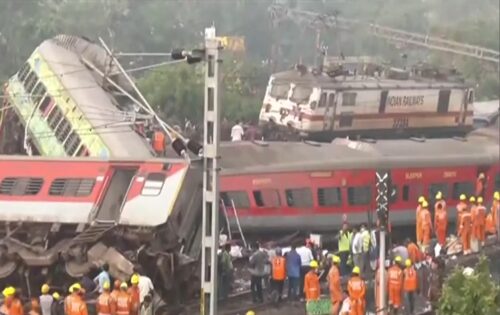Rama Krishna Sangem
Indian Railways carry around 2.6 crore passengers on its 13,600 trains every day. Another 8,450 goods trains run carrying 30 lakh tonnes of items per day. These close to 21,000 trains crisscross around 7,420 railway stations across the country. They run on tracks with length of around 1,05,000 km. So, imagine the amount of activity on railway tracks.
Latest Balasore train tragedy makes me to take a look at our Indian railways’ background.
And the worst part? Every year, on an average around 13,000 people die of either railway accidents or mishaps. There are around 12,50,000 employees in Indian Railways, and 92 per cent of them are lower level while only 7-8 per cent are top level technocrats or administrators. There are 52 railway zones and dozens of major wings that takes care of railways needs and operations.
Only 58 per cent of its tracks are electrified while the rest are still being electrified. Railways, as the public transporter of India enjoys monopoly. except in some tourist routes. Railways, as per 2023 budget figures, earn Rs 2,67,000 crore of annual revenues while the net profit is around Rs 7,4000 crore. This is more than the budget of a big state in India.
Old & modern co-exist
Indian railways is a peculiar institution. First train operated on from Bombay to Thane, on a track of about 34 km, on April 16, 1853,by the East India Company. That was 4 years before last Mughal Bahadur Shah Jafar was removed from power in Delhi in 1857. Gradually, the East India Company went on expanding railway tracks. In the beginning, there were steam engines, and horse drawn carriages.
Our own Nizam Nawabs brought railways to Hyderabad in 1879 – by inaugurating Kacheguda railway station – to Hyderabad. First narrow gauge then meter gauge and later broad guage tracks were laid. Steam engines were replaced by coal ones and finally electric trains occupied railway tracks. Thousands of unmanned level crossings were replaced with signals and fully manned.
In spite of all these developments, Indian railways are not free from frequent accidents. According to a railway historian, very large number of Indians die because of Indian Railways – no other means. According to rough estimates, more than a million people died of train accidents in India. Hundreds of inquiry committees were formed, and reports submitted, but we are still not from from accidents.
Here old and most modern co-exist. On the one hand, people die of train accidents, millions are injured and crippled. There are still many unmanned level crossings, while we get modern world class trains like Vande Bharat or Rajadhani expresses etc. Certain routes like Delhi -Mumbai get priority attention while others in remote and backward areas are most neglected.
Kavach, an anti-collision system was claimed to have been developed by our railway research and standards organisation, way back in 2012. But, not much progress is there. Our railway authorities go fixing this system on one route – of around 1,400 km – at a time, per year. At this rate, it will take decades by the time, our entire 1.05 lakh km routes are fixed with this modern systems.
Only a major revamp can better our Indian railways, to save lives of Indians!

